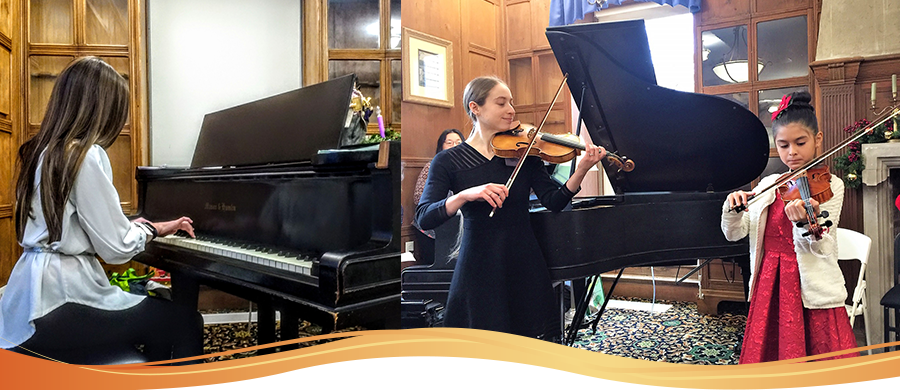
Online
Music for the Community
If you're interested in a particular category, you can sort performances by student age, instrument, singalong music, composer and so on - click on the orange tags under the text. We hope you and your family will enjoy watching our students share their music!
To have each week's videos and accompanying info sent to your inbox*, please subscribe via the orange button.
*Videos are delivered twice weekly; you can unsubscribe at any time, and we will never share or sell your info.
Subscribe to this Page
Displaying items by tag: Singalong
Day 57 - Chant Arabe by Chwatal
Pianist age 8 plays "Chant Arabe" by F. X. Chwatal
Franz Xaver Chwatal (1808 – 1879) was a Bohemian pianist, composer and music teacher. He was the son of an organ builder, who gave him piano lessons as a child. He wrote many pieces of lighter popular music such as this one.
Like so many other pieces we’ve featured, this one is in A – B1/B2 – A form, giving it a pleasing symmetry. In the A section, you can hear the pianist’s left hand playing one chord that’s repeated over and over, like the unchanging, rhythmic plod of the camels across the desert.
There are several singalong options here – try them all, and let us know in the comments which one you like best!
(A) In far-off desert lands, where the oasis stands, camels in caravans trail across burning sands.
(B1) Riders in flowing turbans sit / high atop the swaying animals;
(B2) Bells tinkling, jingling, sweetly ring / out across the desert air and gently tell us...
(A) In far-off desert lands, where the oasis stands, camels in caravans trail across burning sands.
~ or ~
(A) I am thirsty and hot; I am thirsty and hot; I am thirsty and hot; I am thirsty and hot!
(B1) I sure would like some lemonade; / Mother may I? Honey, yes you may. (B2) I sure would like some lemonade; / will you get some for me now? Just wait a minute....
(A) I sure like lemonade; I sure like lemonade; I sure like lemonade, when I’m thirsty and hot.
~ or ~
(A) Oh, it’s hot, very hot! Oh, it’s hot, very hot! Oh, it’s hot, very hot! Oh, it’s hot, very hot!
(B1) Softly the camels tread with their / heavy load across the burning sand;
(B2) Under the blazing sun they plod / on and on and on across the endless desert....
(A) Oh, it’s hot, very hot! Oh, it’s hot, very hot! Oh, it’s hot, very hot! Oh, it’s hot, very hot!
Day 53 - Mary Had a Little Lamb (piano)
Pianist age 4 plays "Mary had a Little Lamb"
We've shown Mary had a Little Lamb before, on flute, but of course it sounds very different on piano. People are often surprised to learn that although the piano has strings, it's actually classifed as a percussion instrument. But percussion basically means "instruments that make their sound when you hit them," and that's what's happening here: when you press the piano keys, they operate hammers inside the piano, which hit the strings and bounce off again.
So an important skill for pianists is learning to touch the keys with enough strength for those hammers to produce a sound - but not so much that the sound is harsh. Although he's so young, you can see (and hear) that this young man is already doing an excellent job using the weight of his arm to drop his fingers into the keys, producing a round, ringing sound.
You probably already know that words to this song! But just in case:
Day 51 - The Happy Farmer
Violinist age 8 plays "The Happy Farmer"
German composer and pianist Robert Schumann lived from 1810 to 1856. He was a brilliant pianist and intended to make a career as a perfomer. Unfortunately a hand injury put an end to that idea, so thereafter he focused on composing.
Meanwhile, he had fallen in love with his piano teacher's daughter, Clara Wieck - herself a wonderful pianist - but her father was very opposed to their marriage. Robert eventually won out, though, and married her in 1840 after a court battle.
By 1848 he and Clara had three young daughters (they eventually had eight children, seven of whom survived). He composed a collection of 43 easy piano pieces for them, "Album for the Young", and The Happy Farmer is one of these pieces. As with our other singalong songs, the words reflect the musical structure, which is little unusual here: A1 - A1 - B - A2 - B - A2, with the A section having two different endings. The B section is very short: the farmer (A) barely lets his wife (B) get a word in edgewise before interrupting her again!
Day 47 - Lightly Row
Pianists age 6 and 8 play Lightly Row
Day 39: Not Jingle Bells; Row, Row, Row your Boat; and......?
Pianist age 6 plays "This is not Jingle Bells" and "Row, Row, Row your Boat"
Day 37: Red Parrot, Green Parrot
Violinist age 8 plays "Red Parrot, Green Parrot" by Edwards Huws Jones
Day 33: I Want a Popsicle
Day 33: Violinist age 5 plays Twinkle Variation D, “I Want a Popsicle”
Day 27: Go, Tell Aunt Rhody (Skills, part 2)
Violinist age 8 plays Go Tell Aunt Rhody
Day 24: Down Pony, Up Pony
Violinist age 5 plays Twinkle Variation C, "Down Pony, Up Pony"
Here is another variation on Twinkle, from one of our young Wayland Rec beginners. Again, this bowing pattern will show up later in much more advanced repertoire.
For violin, viola and cello, we call this variation “DOWN pony, UP pony” to emphasize the alternating direction of the strong bow strokes. Others like to call it “Long, short-short, Long, short-short”, while our Suzuki piano teachers often use “Run Mommy, Run Daddy”. Pick one of these, and see if you can keep up singing it all the way through - or maybe chase Mom and Dad around the house!


